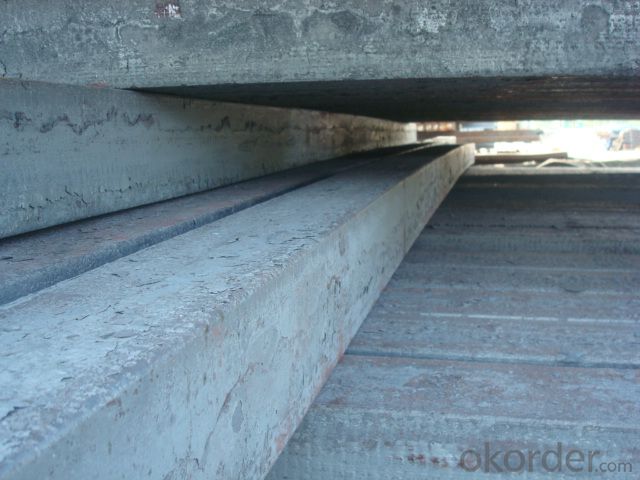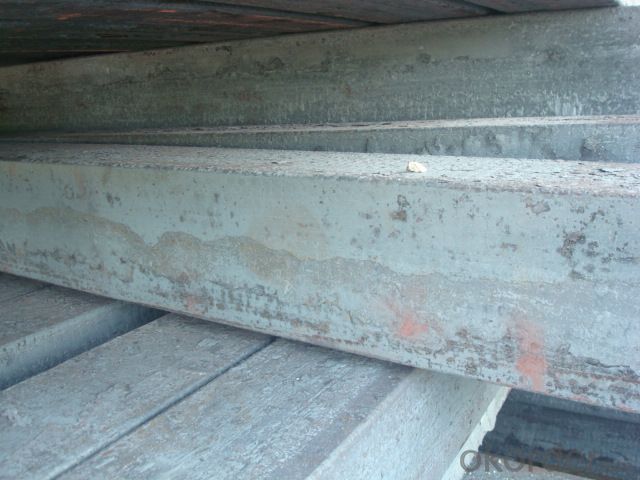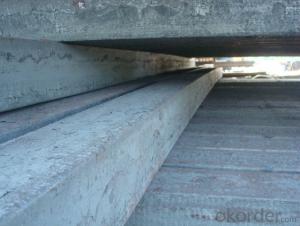Blast furnace billet steel for size 50mm-180mm
- Loading Port:
- Tianjin
- Payment Terms:
- TT OR LC
- Min Order Qty:
- 1000 m.t.
- Supply Capability:
- 30000 m.t./month
OKorder Service Pledge
OKorder Financial Service
You Might Also Like
STEEL BILLET
1.Brief description
Steel billet(ingot) by cogging or breakdown of semi-finished products, is the raw material of all kinds of steel mill. Billet section of square, round, flat, rectangular and abnormity of several kinds of, mainly related to the shape of rolled products.
2.Features
Rectangular billet continuous casting billet and mainly general carbon steel, low carbon low silicon cold-rolled material, high quality carbon structural steel, high strength low alloy steel, special steel, etc.
The billet is mainly divided into two kinds from the shape:
Slab: cross section width and height of the ratio of the larger, mainly used for rolling plate.
Billet: equal cross section width and height, or a huge difference, mainly used for rolling steel, wire rod. ,
Steel billets have distinct characteristics as compared with already furnished steel bars and products. Billets have a specific grain structure, which enables the metal to be processed more intricately. Steel billets are also known for their malleability and ductility, especially when exposed to varying temperatures during shaping and molding.
3.Processing
Steel billets are considered fresh and raw, and they must undergo a series of manufacturing processes before they can be used for various purposes. Billets are made by means of freezing molten liquid, and are later exposed to extremely low temperatures in order to allow the metal to take shape and solidify in chemical structure. The temperature manipulates the metal's physical properties, and tones its strength and durability. The subsequent processes provide the metal's curved mold design so that it can fit the allotted space provided by other machines, which complete the finishing procedures.
4.Pictures


5.Usage
Billets, or ingots (as they sometimes referred to), are not of practical use until they have been formed into more functional shapes and sizes. While they have already been put in the furnace, they still require a series of shaping and molding procedures such as hot and cold working, milling and cutting before they are sold in hardware stores, or used for different applications. The unformed billets, however, can be used in striking currency such as coins and as reserves, similar to gold bars.
6.Detailed specification
Hot rolled billet steel
Size: 50x50mm-180x180mm
Steel Grade: 3SP, 5SP,Q195,Q235,Q255,Q275 Length:3m-12m
MOQ: 1000MT/size
Payment term: TT or LC
Packing: in bulk , bundle
Shipment: by container , bulk vessel
Packaging Details: bundles with steel strips or as customers's requirements
Delivery time: 15-30 days after the deposit
Loading port:Tianjin, or other port China
Origin : China
Inspection:Third party inspection before loading.
- Q:What are the different methods of surface cleaning for steel billets?
- Some of the different methods of surface cleaning for steel billets include abrasive blasting, acid pickling, mechanical cleaning, and electrochemical cleaning.
- Q:The form of carbon in carbon steels
- There are three solid solutions of carbon in iron: alpha solid solution (Tie Suti), gamma solid solution (austenite) and delta solid solution (8 ferrite). The spatial distribution of iron atoms in these solid solutions is consistent with that of alpha -Fe, gamma -Fe and delta -Fe. The size of carbon atoms is much smaller than that of iron atoms.
- Q:What are the different surface defects found in stainless steel billets?
- Stainless steel billets may exhibit several surface defects. Some commonly encountered defects include: 1. Scale: During the heating process, a thin layer of oxide known as scale forms on the billet's surface. It manifests as a rough, dark layer and can be easily eliminated through pickling or passivation methods. 2. Pitting: Localized corrosion, resulting in small, shallow pits on the billet's surface, is referred to as pitting. It occurs due to chloride ions or other aggressive chemicals and may compromise corrosion resistance. 3. Scratches: Linear marks visible on the billet's surface are indicative of scratches. These scratches can occur during handling, transportation, or processing, potentially impacting the material's appearance and integrity. 4. Lamination: Improper rolling or inadequate bonding during manufacturing can lead to lamination defects, which manifest as thin layers or flakes parallel to the billet's surface. 5. Inclusions: Non-metallic particles or impurities embedded in the stainless steel billet are referred to as inclusions. They have the potential to affect the material's mechanical properties and corrosion resistance. 6. Decarburization: Heating may cause carbon loss from the billet's surface, resulting in decarburization. This manifests as a light-colored layer and can adversely affect the material's strength and hardness. 7. Cracks: Thermal stresses, improper cooling, or mechanical damage can cause cracks in the billet. These cracks can be either surface cracks or internal cracks, significantly weakening the billet. Detecting and addressing these surface defects is crucial to ensure the quality and performance of stainless steel billets across various applications.
- Q:How are steel billets used in the manufacturing of automotive parts?
- Steel billets are an essential raw material used in the manufacturing of automotive parts. These billets, which are typically short, solid pieces of steel, serve as the starting point for various automotive components. Firstly, steel billets are heated and then passed through a series of rolling mills to convert them into different shapes and sizes. This process, known as hot rolling, allows the steel billets to be transformed into bars, rods, or sheets that can be further machined or formed into automotive parts. The automotive industry relies heavily on steel billets to produce a wide range of components, such as engine blocks, crankshafts, suspension parts, and chassis frames. These parts require high strength and durability to withstand the demanding conditions of vehicles. Engine blocks, for example, are typically made from cast iron or aluminum alloys produced from steel billets. The billets are melted and poured into molds to create the desired shape, which forms the foundation of the engine. Similarly, crankshafts, which transfer power from the engine to the wheels, are often forged from steel billets to ensure strength and precision. Suspension parts, such as control arms and torsion bars, also rely on steel billets for their manufacturing. These parts need to withstand the forces and impact of the road, and steel provides the necessary strength and resilience. Billets are machined and shaped to create the required geometry and then assembled with other components to form the suspension system. Additionally, steel billets are used in the production of chassis frames, which provide the structural integrity and support for the entire vehicle. These frames are typically made from steel tubes or sections formed from billets. The billets are shaped, welded, and joined together to create a strong and rigid framework that gives stability and ensures safety. In conclusion, steel billets play a crucial role in the manufacturing of automotive parts. With their versatility and strength, they are transformed into various components that form the backbone of vehicles, ensuring durability, performance, and safety on the road.
- Q:How are steel billets used in the production of oil and gas components?
- Due to their strength, durability, and ability to withstand extreme conditions, steel billets are indispensable in the production of oil and gas components. These billets serve as essential raw materials in various manufacturing processes for creating the equipment and parts required in the oil and gas industry. One notable application of steel billets in the oil and gas sector is their use in manufacturing pipes and casings. These billets are heated and then rolled or forged into seamless or welded pipes, which are utilized for transporting oil and gas from wells to refineries or distribution centers. The high strength of steel billets ensures that these pipes can endure the high pressure and corrosive nature of the substances being transported. Steel billets are also integral to the production of valves, flanges, and fittings, which are critical components in oil and gas infrastructure. These billets are machined or forged into various shapes and sizes to create these components, used for controlling the flow of oil and gas within pipelines or at different stages of the production process. The durability and resistance to corrosion of steel billets make them ideal for these applications, as they can endure the harsh conditions often encountered in oil and gas operations. Moreover, steel billets find utility in the production of drilling equipment such as drill bits, drill collars, and drill pipes. These billets are frequently treated with heat or alloying elements to enhance their strength and wear resistance. The resulting components can withstand the intense forces and abrasion experienced during drilling operations, ensuring efficient and reliable extraction of oil and gas reserves. In conclusion, steel billets play a crucial role in the oil and gas industry by providing the essential raw materials for manufacturing durable and high-performance components. Their strength, durability, and resistance to corrosion make them an ideal choice for the challenging conditions encountered in the production, transportation, and processing of oil and gas.
- Q:What are the different types of cleaning methods used for steel billets?
- Steel billets can be cleaned using several methods, each with specific requirements and desired results. Here are some commonly used cleaning methods for steel billets: 1. Acid cleaning: To eliminate rust, scale, and grease, acid solutions are applied. This method effectively removes tough stains and corrosion, but it necessitates careful handling and proper disposal of acidic waste. 2. Shot blasting: High-speed projectiles are used to impact the surface of steel billets, removing rust, scale, and other impurities and leaving a polished finish. Shot blasting is often employed for large-scale cleaning and can be automated for efficiency. 3. Pickling: Steel billets are submerged in an acid solution, typically hydrochloric or sulfuric acid, to eliminate oxide layers and impurities, resulting in a clean and corrosion-resistant surface. 4. Ultrasonic cleaning: By agitating a cleaning solution with high-frequency sound waves, microscopic bubbles are created, aiding in the removal of dirt, grease, and contaminants from the steel billet's surface. This method is particularly effective for fine particles and hard-to-reach areas. 5. Electrolytic cleaning: A direct electric current is used to attract surface impurities from the steel billets. Immersed in an electrolyte solution, the billets undergo cleaning as the impurities adhere to an electrode. 6. Chemical cleaning: Specialized chemicals are employed to dissolve or react with surface contaminants like rust, oil, or paint. The choice of chemicals depends on the type of contaminant and the desired outcome. Chemical cleaning effectively removes both organic and inorganic substances from steel billets. In conclusion, these various cleaning methods offer diverse approaches to achieve a clean and polished surface for steel billets, ensuring their quality and suitability for further processing or applications.
- Q:How are steel billets used in the production of shipbuilding components?
- Steel billets are essential in the production of shipbuilding components as they serve as the primary raw material. Shipbuilding components require a high level of strength, durability, and corrosion resistance, all of which can be achieved through the use of steel billets. Firstly, steel billets are heated and then passed through a series of rolling processes to produce various shapes and sizes of steel plates, beams, and bars. These components are crucial in the construction of the ship's hull, superstructure, and other structural components. For example, steel plates are used to form the ship's outer shell, while beams and bars are utilized to provide support and stability. Furthermore, steel billets can be forged or machined to create specialized shipbuilding components such as propeller shafts, rudder stocks, and engine mounts. These components play vital roles in the ship's propulsion system, steering mechanism, and overall functionality. Additionally, steel billets can be used to manufacture pipes and tubes that are crucial for the ship's plumbing, ventilation, and fuel systems. The use of steel billets in shipbuilding ensures the vessels are built to withstand the harsh marine environment, including extreme weather conditions and corrosive seawater. Steel is known for its high strength-to-weight ratio, making it an ideal choice for constructing large and sturdy ships. Moreover, steel is easily weldable, allowing for efficient assembly and fabrication processes during ship construction. Overall, steel billets are a fundamental component in shipbuilding, providing the necessary strength, durability, and corrosion resistance required for the construction of various ship components. From the hull and superstructure to specialized parts, steel billets are indispensable in the production of shipbuilding components.
- Q:How are steel billets used in the production of seamless pipes?
- Seamless pipes, which are manufactured without welding or seams, require steel billets as a fundamental component in their production process. Steel billets are rectangular-shaped solid pieces of steel that serve as the raw material for seamless pipe manufacturing. To produce seamless pipes, the initial step is melting steel in a furnace to obtain molten metal. This molten steel is then poured into molds to shape steel billets. These billets are then heated to a specific temperature and pierced using a piercing mill. This mill exerts both axial and radial forces, pushing a pointed mandrel through the center of the billet, resulting in a hollow tube or shell. Following the piercing process, the hollow tube is further elongated and reduced in diameter by a series of rolling mills. These mills apply a combination of rotational and compressive forces to shape the billet into the desired seamless pipe size. The seamless pipe undergoes continuous stretching and rolling until it reaches the desired length and diameter. The utilization of steel billets in the production of seamless pipes holds significant importance for several reasons. Firstly, the billets are crafted from high-quality steel, guaranteeing the strength and durability of the final product. Secondly, the uniformity and consistency of the billets allow for precise shaping and seamless pipe dimensions. Lastly, the solid structure of the billets enables them to withstand the intense forces and temperatures involved in the pipe manufacturing process. In conclusion, steel billets assume a crucial role in the production of seamless pipes. From being melted and molded into billets to being pierced, elongated, and rolled, these billets undergo a series of processes that transform them into high-quality seamless pipes. The use of steel billets ensures the integrity and reliability of seamless pipes, making them suitable for various industrial applications.
- Q:How are steel billets used in the manufacturing of fasteners?
- Steel billets are used in the manufacturing of fasteners as they serve as the raw material for creating a variety of fastener types, including screws, bolts, and nuts. These billets are heated and then forged or rolled into the desired shape and size, forming the base of the fastener. The high strength and durability of steel make it an ideal material for fasteners, ensuring secure and reliable connections in various applications.
- Q:What is the role of steel billets in the manufacturing of hydraulic cylinders?
- Steel billets play a crucial role in the manufacturing of hydraulic cylinders as they are the raw material used to create the cylinder body. The billets are heated and then shaped into the desired cylindrical form through processes like hot rolling or forging. This allows for the production of strong and durable cylinders that can withstand high pressure and various operating conditions.
1. Manufacturer Overview |
|
|---|---|
| Location | |
| Year Established | |
| Annual Output Value | |
| Main Markets | |
| Company Certifications | |
2. Manufacturer Certificates |
|
|---|---|
| a) Certification Name | |
| Range | |
| Reference | |
| Validity Period | |
3. Manufacturer Capability |
|
|---|---|
| a)Trade Capacity | |
| Nearest Port | |
| Export Percentage | |
| No.of Employees in Trade Department | |
| Language Spoken: | |
| b)Factory Information | |
| Factory Size: | |
| No. of Production Lines | |
| Contract Manufacturing | |
| Product Price Range | |
Send your message to us
Blast furnace billet steel for size 50mm-180mm
- Loading Port:
- Tianjin
- Payment Terms:
- TT OR LC
- Min Order Qty:
- 1000 m.t.
- Supply Capability:
- 30000 m.t./month
OKorder Service Pledge
OKorder Financial Service
Similar products
New products
Hot products
Related keywords






























